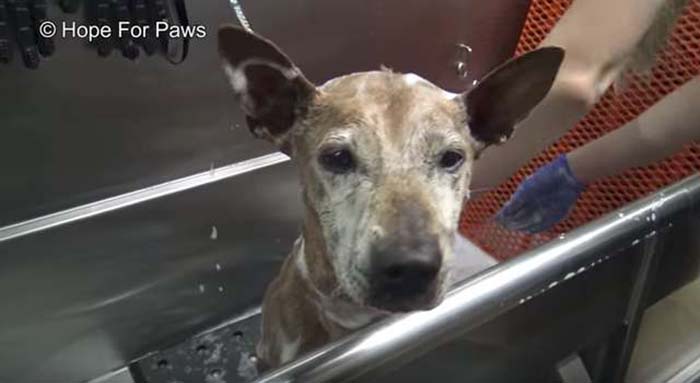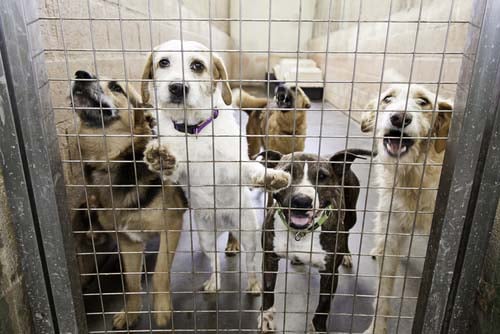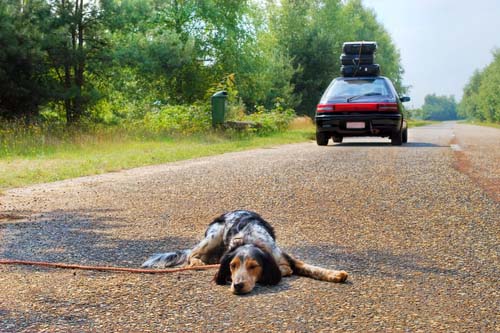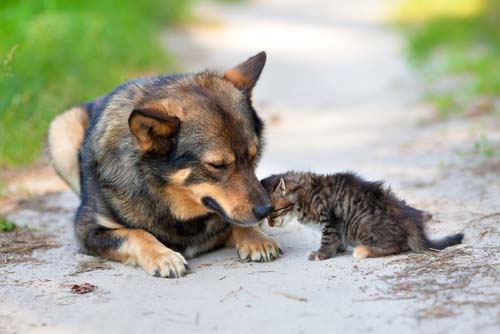The internet is full of sad homeless pets stories like the one of Al and Oolu. Al Ritch found the senior dog Oolu lost and abandoned in a busy shipping port in Los Angeles. He gave her the name Oolu because it is short for the container where he saw her first.
Table of Contents
- 15 Facts About Homeless Pets
- 1. Statistics on Homeless Dogs and Cats are Astounding
- 2. Millions of Homeless Pets are Euthanized Every Year
- 3. Overcrowding is a Real Problem in Shelters
- 4. Most Homeless Dogs Have No Proper Identification
- 5. More Rescue Groups Established in the Last Decade
- 6. Taxpayers Pay for the Operation of City Shelters
- 7. Shelters Don't House Just Cats and Dogs
- 8. Pit Bulls are the Most Often Euthanized Breed
- 9. Purebred Dogs are Also Very Likely to be Abandoned
- 10. Black Fur Animals are Less Likely to be Adopted
- 11. Adopting a Dog from a Shelter is Fairly Cheap
- 12. You're Adopting a Unique Pet
- 13. Most Homeless Pets in Shelters are in Good Health
- 14. Many Shelter Dogs Have Been Housebroken
- 15. You're Saving a Life When Adopting from Shelters
This particular story was recorded with participation of Hope for Paws, a non-profit animal rescue organization. So, Al tried to win the dog's trust by feeding and making sure she's safe in a confined space so that she would no longer wander off until rescuers have taken her in. The dog has been distrustful of humans because of what she went through.

Al got the help of Loreta Frankonyte and Eldad Hagar from Hope for Paws in making sure that Oolu goes to a shelter. But before they could do this, Loreta and Eldad also had to win over Oolu. They took time by sitting with the dog to allow her to get to know the humans so that she won't be traumatized further.

When Oolu decided she could trust the humans, Loreta placed a leash on her neck and led her to the car to bring her to the shelter vet. The homeless dog met more humans she could trust as they bathed and treated her skin infections.

Not long after, Oolu was placed in a forever home that would love like family. She's no longer the scared and distrustful dog and she can look forward to her golden years happily among people who love her.

But while Oolu was fortunate, millions of homeless dogs and cats remain without a forever home. Because it's important to raise awareness of homeless pets and non-profit rescue organizations that help them, below are 15 sad but important facts to know about homeless pets some of which you probably didn't know. And if you'd like to help these animals and rescue organizations, you can adopt them or make donations.
15 Facts About Homeless Pets
1. Statistics on Homeless Dogs and Cats are Astounding
For every 10 dogs born, only one of them will have a forever home. This is a concerning problem since there are at least 70 million stray animals in the United States alone and only less than eight million find their way into shelters.
About 20 percent of these shelter animals are reclaimed or returned to their owners, while less than four million are adopted. The rest end up being euthanized to make space inside shelters for incoming new stray dogs and cats.
2. Millions of Homeless Pets are Euthanized Every Year
Unfortunately, sometimes this is a necessary inconvenience. Millions of cats and dogs are put down every year in shelters to prevent overcrowding and with the goal to save others. PETA's stance on euthanasia may be controversial among some animal lovers, but more shelters, rescue organizations seem to agree that sometimes, there's no other option.
Anissa Perez, an independent reporter who also rescues dogs, agree that it's a necessary evil that occasionally is unavoidable. About 5,500 shelter dogs are killed every single day and most of them are generally healthy animals with treatable conditions. The high number prompted artist Mark Barone to create “An Act of a Dog,” a memorial museum that should help raise awareness about pet homelessness.
3. Overcrowding is a Real Problem in Shelters
The major reason that contributes to the overpopulation in shelters is the fact that many animal shelters and rescue organizations cannot afford to spay or neuter all pets, and provide them with other essential care.
The truth is that shelter operators receive only 10 percent of animals that have been spayed or neutered by their former owners. Hence, dogs accidentally or mate when they're with their former owners, thus adding to overpopulation. It's also adding to the animals killed every year.
4. Most Homeless Dogs Have No Proper Identification
Majority of rescued dogs that end up in a shelter cannot be turned over to their owners because they don't have collared tags or microchip. Some dogs, on the other hand, don't have an updated detail of their owners in their identification.
At least 74.1 percent of lost dogs with good identification can be reunited with their owners. Responsible pet owners should have their pets tagged and microchipped at the vet but that doesn't happen often enough. They must also update their details if they move to a new home or obtain a new number.
5. More Rescue Groups Established in the Last Decade
There are at least 10,00 rescue groups and animal shelter organizations as well as related types of animal sanctuaries in America alone. This is on top of the thousands of local city shelters and rescues. The rise of such organizations with the goal to save dogs and cats and reduce pet homelessness problem actually resulted in plummeting euthanasia rates.
6. Taxpayers Pay for the Operation of City Shelters
The operation, upkeep, and care of stray animals cost taxpayers at least two billion a year. However, breaking it down among all shelters and their animals, this actually ends up a small amount of money for each of them. Majority of funds rescue organizations receive come from donations. Whatever the case, if pet owners would become more responsible in taking care of dogs and other pets, all this money could be saved.
7. Shelters Don't House Just Cats and Dogs
Though the most common animals in shelters are homeless dogs and cats, some rescue organizations and shelters also take in birds, goats, guinea pigs, horses, snakes, and rabbits. This further contributes to the overpopulation and other related problems in shelter sites, which puts more pressure on everyone involved.
8. Pit Bulls are the Most Often Euthanized Breed
Reports reveal that 93 percent of pit bulls in shelters aren't being given a chance to be adopted. Instead, they are killed off first compared to other breeds because of this breed's reputation as a more aggressive dog. The well known stereotype is still going strong, even though some animal experts attempt to debunk it.
9. Purebred Dogs are Also Very Likely to be Abandoned
In most cases, purebred dogs aren't the type who you'd expect to roam the streets. Their owners, who might have no idea about their breed’s personality type before buying dogs, usually give them up. Hence, it's important for owners to study or research on the breed first before bringing home a dog.
10. Black Fur Animals are Less Likely to be Adopted
Interestingly, homeless black dogs or black cats are often overlooked for adoptions and they have the lowest rates of getting new forever homes after being abandoned. Experts explain that this might be due to superstitions as people equate black animals with bad luck or something evil, and this phenomena is known as “black dog syndrome.”
11. Adopting a Dog from a Shelter is Fairly Cheap
At least 65 percent of owners pay nothing to adopt a rescue dog. If they have to shell out money, it's likely due to the dog's medical needs or an adoption fee. Even then, the amount is usually minimal and won't cause a dent in your bank account, and it's significantly cheaper than buying from a breeder.
12. You're Adopting a Unique Pet
In most cases, homeless animals in shelters are crossbreeds whereas there's only about 25 to 30 percent of pure breeds. Crossbreeds look especially unique and develop well-defined characteristics. Other than bragging about rescuing a dog instead of buying one from a puppy mill, you also get the right to brag about you having a unique pooch, which is a plus in my book.
13. Most Homeless Pets in Shelters are in Good Health
The most common health problem of shelter dogs is malnutrition due to being homeless in the streets for weeks or months. Skin irritation is also a problem but most animals generally have a treatable condition and hardly have any major medical problems. Staff at animal shelters and rescue organizations take great care of abandoned dogs and cats, and by the time you adopt one, they'll be in a healthy condition.
14. Many Shelter Dogs Have Been Housebroken
A lot of previously homeless dogs up for adoption at shelters have been trained or housebroken hence it’s easier to raise them in your home. You won't need to spend as much money on trainers or scratched furniture. Senior dogs are especially well-behaved and mild-mannered. They’re the perfect home companions.
15. You're Saving a Life When Adopting from Shelters
When you adopt instead of buy dogs, you're giving these previously homeless animals a second chance in life by adopting them into your family. You're giving them a forever home and finally a good chance to live a happy and dignified life as your pet.
There's a number of reasons to adopt a dog instead of buy one from a pet store or dog breeder. Having a rescue dog can enrich your life in many ways. If you’re interested in adopting one, contact your local shelter or a rescue group for more details on where and how to get started, or how you can otherwise help homeless pets if you cannot adopt.
READ NEXT: 12 Reasons Why Senior Dogs Are Better Than Puppies


















